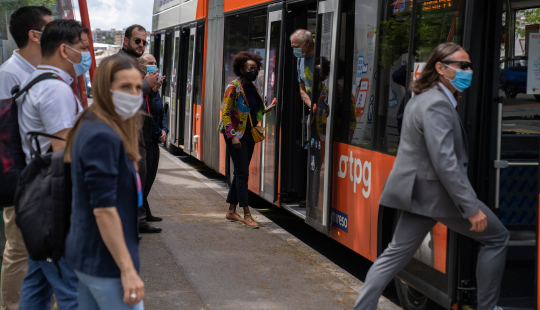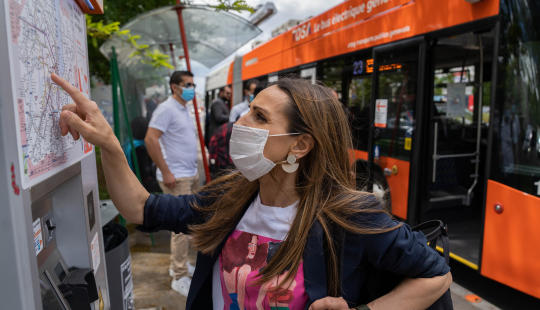Covid-19 and teleworking : the importance of having a mobility plan
Flexibility, accessibility, productivity, awareness of the negative environmental impact of commuting... There are many reasons to want to work from home at least a few days a week. But since 2020, it's no longer a matter of choice: for many, the COVID-19 pandemic has made teleworking mandatory. Companies were then forced to adapt to a new reality, implement accelerated changes and seize the opportunity to rethink mobility.
Covid-19 and teleworking: what impact on daily mobility in companies?
The coronavirus emergency and social distancing requirements have forced many companies and organizations around the world to let their staff work from home and rethink their production and organizational processes. In this context, meeting the challenge of remote work involves completely rethinking the way of working and mobility within companies.

Teleworking and new forms of mobility, the legacy of the pandemic
We live in an era of change where people, even before companies, are increasingly trying to align their daily choices with their social and environmental concerns. Sustainable mobility is becoming a virtuous way of interpreting our daily lives, a way of life. This is why mobility must play an increasingly important role in a business revolution that, due to the urgency, pushes us towards an even more difficult but necessary change for the future.
In order to understand to what extent the transition to teleworking that we are currently experiencing will have positive effects in terms of environmental sustainability, it is necessary to improve knowledge of the demand for mobility. We must be careful not to confuse what is an emergency action dictated by the need to stop the epidemic, with real innovations in the medium and long term. Thus, sustainable mobility becomes a virtuous way of interpreting our daily lives: rethinking mobility is no longer an option.
For teleworking to have positive effects in terms of environmental sustainability, it is necessary to improve knowledge of the demand for mobility.
Teleworking: the need for companies to set up a mobility plan
Remote work, which has gained momentum since the beginning of the Covid-19 pandemic, is an effective measure in the field of sustainable mobility. It eliminates avoidable commuting and therefore also reduces CO2 emissions. But it is even more effective when it is part of a global policy of sustainable mobility in companies. Thus, the implementation of a mobility plan is an effective solution to adopt and analyze new mobility measures.

What is a mobility plan?
As its name suggests, it is a strategic project that a company develops according to the mobility generated by its activity. In other words, it is a set of measures to streamline the movement of staff, customers and suppliers.
The measures and actions included in mobility plans must have a common objective: to promote more sustainable, efficient and safe mobility. The aim is to avoid the daily use of private motor vehicles to get to work as much as possible. Instead, the company will have to include in its plan strategic lines that promote cycling, electric mobility, active mobility, public transport, etc. In this way, the social, economic and environmental problems caused by the use of private vehicles to get to work can be reduced.
How to set up a mobility plan within a company?
Cities have long expressed mobility needs. Private cars monopolize much of the public space. The situation is pushing municipalities to act. The goal: to put people at the center of the city's redesign. Commuting plays a key role in this.
When developing such a plan, a series of steps must be taken into account that are essential for it to be effective. First, those responsible for drawing up the mobility plan must carry out a preliminary study. It is essential to know the characteristics, problems and deficiencies of the company in terms of mobility in order for the strategy and measures adopted to work.
The measures included in the plan must be approved by all levels of the company. If the plan is designed by only one sector of the company, it will be difficult for the majority to take ownership of it and change their habits. Relations with local government should also be included in this part of the plan. Communities can offer advice and the company must present its needs in areas such as infrastructure or public transport lines.
Once the problems have been identified and the views of all staff have been heard, it is time to devise measures to address the deficiencies. The next step is to undertake these actions and, finally, to check whether the results are in line with expectations.
As you will have understood, the mobility plan guarantees the company's commitment to the environment, but also to its own employees. This is because, by promoting sustainable mobility, companies are able to work in favor of the environment but also to improve the quality of life of their staff.
As a major player in Greater Geneva's transport, tpg knows the territory. For example, tpg has set up tpgEvomoov, an all-in-one platform dedicated to ecomobility, which focuses on understanding how your employees move and the daily constraints that affect their mobility., Depending on the real needs identified, tpg brings you global and standardized solutions! Do you have a project? Any questions? Do not hesitate to contact us.


